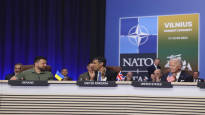asked politicians and scientists at the NATO summit what the future of the military alliance looks like.
Defense Minister Antti Häkkänen (collective):
“In my opinion, the Defense Association remains in an excellent position. We have unity, especially regarding the Sweden solution. Finland, as a new member, is united in the fact that we have to defend ourselves more strongly.”
“Another thing is that there will be much more strength in NATO’s own activities. Our troop and command structures are getting stronger and we are preparing to defend everything from the Arctic to the Mediterranean. Thirdly, we will also clearly have determination in NATO about what the threat images are, so it is not guesswork. The main threat images are related to Russia.”
Foreign Minister Elina Valtonen (coordinator):
“Now it is very important that we agree on steps and a program within which the cooperation between NATO and Ukraine can become even closer.”
“Finland has a lot to offer in that we can help and support Ukraine to achieve the membership criteria that we have also achieved at this moment. Of course, it concerns the Ukrainian army and its compatibility with NATO, but equally the entire Ukrainian society and democracy.”
Charly Salonius-Pasternak, leading researcher, Foreign Policy Institute:
“I would say that NATO leaves the meeting more united. The contradictions are visible here in the public eye, because we are talking about relatively open countries and societies with a free press. The discussion is visible in a way that is not visible in, for example, China.”
“Ultimately, all these different countries and members have been able to make decisions together that concretely improve the security of NATO and the individual member countries. The end result has moved NATO forward as an organization and once again developed and improved Finland’s security as well.”
Anna Wieslander, Director of Northern Europe, Atlantic Council think tank:
“If Turkey had not given Sweden the green light, the Vilnius meeting could not have been considered successful. The negotiations between Sweden and Turkey were difficult and required diplomatic efforts. by Ulf Kristersson the government did a lot of legwork in them, the allied countries and also the secretary general Jens Stoltenberg alongside.”
“The prolongation of Sweden’s NATO membership process made NATO look unnecessarily weaker and more fragmented. This would not have been necessary if Turkey had agreed earlier. Sweden didn’t have much more to give when Turkey gave Finland the green light. Sweden has lost some months, but at the end of the day, the approval of each member state is needed – that’s how NATO works.”
“Now that a consensus was found on Sweden’s NATO membership, Natok’s strength and unity is shown again. I don’t think the prolongation has left bad blood between the countries. On the other hand, we cannot know how things will develop from this.”
Oleksiy Goncharenko, Ukrainian MP:
“The declaration made in Vilnius (about Ukraine) is not a success, but it is not a failure either. This is the first step in a process that could be shorter, but unfortunately NATO is not ready to make bold decisions. So we have to wait for NATO to take the next step. Hopefully it will happen next year at the summit in Washington.”
“Some of the member countries seem to fear Russia, which the Ukrainians do not. Ukraine being left without a clear NATO timetable gives For Putin a sad message that he would still have a chance of winning. Since Ukraine is still not a member of NATO, Putin is trying to destroy Ukraine.”
Kristi Raik, Deputy Director, Tallinn International Defense Center:
“The promises Ukraine received from the G7 countries are significant. It is misleading to talk about security guarantees here, because Ukraine defends itself within the framework of this model.”
“Of course it is not the same as NATO’s security guarantees, but in this situation the support is significant while the war continues, and it is possible that it will continue for a long time.”
The topic can be discussed until 23.00 on 16 July 2023.
